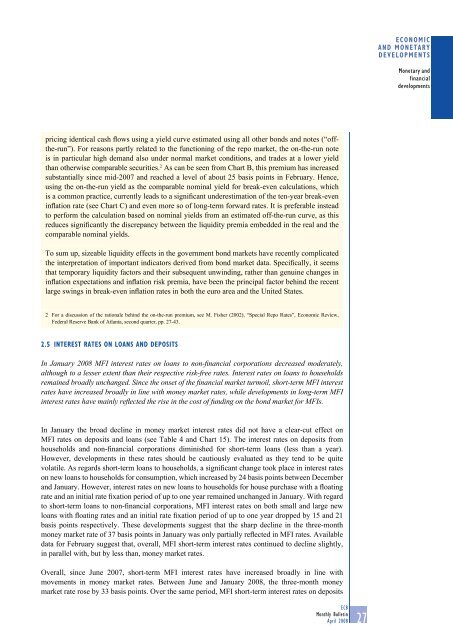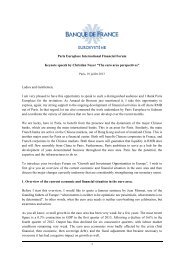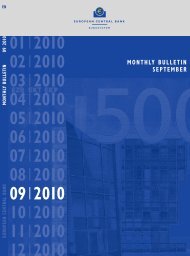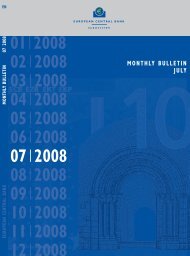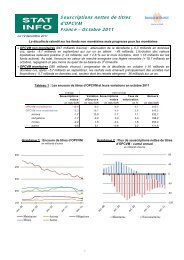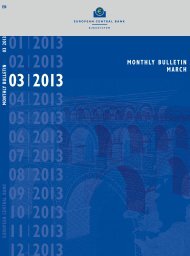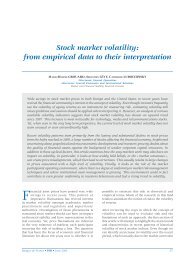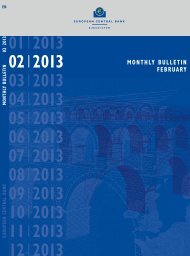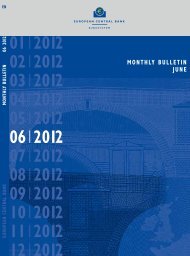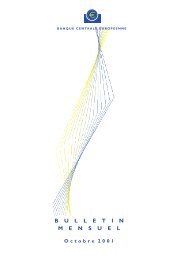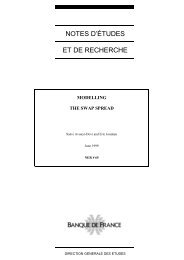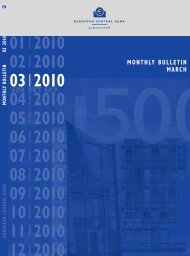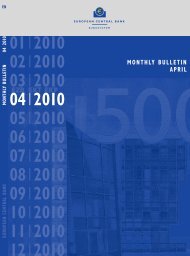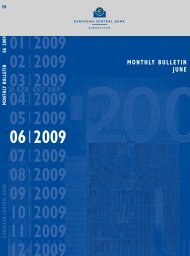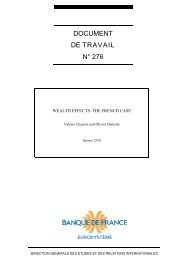Monthly Bulletin April 2008 - European Central Bank - Europa
Monthly Bulletin April 2008 - European Central Bank - Europa
Monthly Bulletin April 2008 - European Central Bank - Europa
You also want an ePaper? Increase the reach of your titles
YUMPU automatically turns print PDFs into web optimized ePapers that Google loves.
ECONOMIC<br />
AND MONETARY<br />
DEVELOPMENTS<br />
Monetary and<br />
financial<br />
developments<br />
pricing identical cash flows using a yield curve estimated using all other bonds and notes (“offthe-run”).<br />
For reasons partly related to the functioning of the repo market, the on-the-run note<br />
is in particular high demand also under normal market conditions, and trades at a lower yield<br />
than otherwise comparable securities. 2 As can be seen from Chart B, this premium has increased<br />
substantially since mid-2007 and reached a level of about 25 basis points in February. Hence,<br />
using the on-the-run yield as the comparable nominal yield for break-even calculations, which<br />
is a common practice, currently leads to a significant underestimation of the ten-year break-even<br />
inflation rate (see Chart C) and even more so of long-term forward rates. It is preferable instead<br />
to perform the calculation based on nominal yields from an estimated off-the-run curve, as this<br />
reduces significantly the discrepancy between the liquidity premia embedded in the real and the<br />
comparable nominal yields.<br />
To sum up, sizeable liquidity effects in the government bond markets have recently complicated<br />
the interpretation of important indicators derived from bond market data. Specifically, it seems<br />
that temporary liquidity factors and their subsequent unwinding, rather than genuine changes in<br />
inflation expectations and inflation risk premia, have been the principal factor behind the recent<br />
large swings in break-even inflation rates in both the euro area and the United States.<br />
2 For a discussion of the rationale behind the on-the-run premium, see M. Fisher (2002), “Special Repo Rates”, Economic Review,<br />
Federal Reserve <strong>Bank</strong> of Atlanta, second quarter, pp. 27-43.<br />
2.5 INTEREST RATES ON LOANS AND DEPOSITS<br />
In January <strong>2008</strong> MFI interest rates on loans to non-financial corporations decreased moderately,<br />
although to a lesser extent than their respective risk-free rates. Interest rates on loans to households<br />
remained broadly unchanged. Since the onset of the financial market turmoil, short-term MFI interest<br />
rates have increased broadly in line with money market rates, while developments in long-term MFI<br />
interest rates have mainly reflected the rise in the cost of funding on the bond market for MFIs.<br />
In January the broad decline in money market interest rates did not have a clear-cut effect on<br />
MFI rates on deposits and loans (see Table 4 and Chart 15). The interest rates on deposits from<br />
households and non-financial corporations diminished for short-term loans (less than a year).<br />
However, developments in these rates should be cautiously evaluated as they tend to be quite<br />
volatile. As regards short-term loans to households, a significant change took place in interest rates<br />
on new loans to households for consumption, which increased by 24 basis points between December<br />
and January. However, interest rates on new loans to households for house purchase with a floating<br />
rate and an initial rate fixation period of up to one year remained unchanged in January. With regard<br />
to short-term loans to non-financial corporations, MFI interest rates on both small and large new<br />
loans with floating rates and an initial rate fixation period of up to one year dropped by 15 and 21<br />
basis points respectively. These developments suggest that the sharp decline in the three-month<br />
money market rate of 37 basis points in January was only partially reflected in MFI rates. Available<br />
data for February suggest that, overall, MFI short-term interest rates continued to decline slightly,<br />
in parallel with, but by less than, money market rates.<br />
Overall, since June 2007, short-term MFI interest rates have increased broadly in line with<br />
movements in money market rates. Between June and January <strong>2008</strong>, the three-month money<br />
market rate rose by 33 basis points. Over the same period, MFI short-term interest rates on deposits<br />
ECB<br />
<strong>Monthly</strong> <strong>Bulletin</strong><br />
<strong>April</strong> <strong>2008</strong><br />
27


